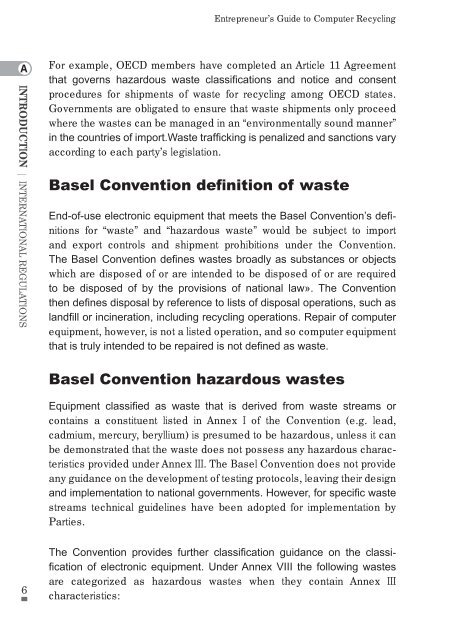The Entrepreneur's Guide to Computer Recycling - e-Waste. This ...
The Entrepreneur's Guide to Computer Recycling - e-Waste. This ...
The Entrepreneur's Guide to Computer Recycling - e-Waste. This ...
Create successful ePaper yourself
Turn your PDF publications into a flip-book with our unique Google optimized e-Paper software.
Entrepreneur’s <strong>Guide</strong> <strong>to</strong> <strong>Computer</strong> <strong>Recycling</strong>AINTRODUCTION | INTERNATIONAL REGULATIONSFor example, OECD members have completed an Article 11 Agreementthat governs hazardous waste classifications and notice and consentprocedures for shipments of waste for recycling among OECD states.Governments are obligated <strong>to</strong> ensure that waste shipments only proceedwhere the wastes can be managed in an “environmentally sound manner”in the countries of import.<strong>Waste</strong> trafficking is penalized and sanctions varyaccording <strong>to</strong> each party’s legislation.Basel Convention definition of wasteEnd-of-use electronic equipment that meets the Basel Convention’s definitionsfor “waste” and “hazardous waste” would be subject <strong>to</strong> importand export controls and shipment prohibitions under the Convention.<strong>The</strong> Basel Convention defines wastes broadly as substances or objectswhich are disposed of or are intended <strong>to</strong> be disposed of or are required<strong>to</strong> be disposed of by the provisions of national law». <strong>The</strong> Conventionthen defines disposal by reference <strong>to</strong> lists of disposal operations, such aslandfill or incineration, including recycling operations. Repair of computerequipment, however, is not a listed operation, and so computer equipmentthat is truly intended <strong>to</strong> be repaired is not defined as waste.Basel Convention hazardous wastesEquipment classified as waste that is derived from waste streams orcontains a constituent listed in Annex I of the Convention (e.g. lead,cadmium, mercury, beryllium) is presumed <strong>to</strong> be hazardous, unless it canbe demonstrated that the waste does not possess any hazardous characteristicsprovided under Annex III. <strong>The</strong> Basel Convention does not provideany guidance on the development of testing pro<strong>to</strong>cols, leaving their designand implementation <strong>to</strong> national governments. However, for specific wastestreams technical guidelines have been adopted for implementation byParties.6<strong>The</strong> Convention provides further classification guidance on the classificationof electronic equipment. Under Annex VIII the following wastesare categorized as hazardous wastes when they contain Annex IIIcharacteristics:
















